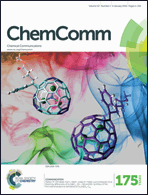Researchers around the world cited ChemComm articles 175,661 times last year, making us the third most cited general chemistry journal, according to the latest citation data released by Thomson Reuters in its 2015 Journal Citation Reports®.
With our Impact Factor riding high at 6.567 and our Immediacy Index at its highest-ever at 1.713, not only are your findings published rapidly in ChemComm, they’re also read and cited quickly by more and more researchers across all chemical science disciplines around the world – proof that we continue to publish urgent, high quality work on the very hottest topics.
A massive thank you to everyone – our authors, referees, readers, Associate Editors, and Editorial and Advisory Board members – for contributing to the journal’s continued success.
With more than 175,000 cites under our belt, we can’t help but think this an apt and fitting way of celebrating our 175 years in the service of the chemical science community as the oldest chemical society in the world.
Submit your next urgent Communication to ChemComm, and quickly see the impact of your work across the breadth of the chemical sciences.
Top cited ChemComm articles:
Feature articles
C–H nitrogenation and oxygenation by ruthenium catalysis
Vedhagiri S. Thirunavukkarasu, Sergei I. Kozhushkov and Lutz Ackermann
Chem. Commun., 2014, 50, 29-39
DOI: 10.1039/C3CC47028H, Feature Article
Intriguing mechanistic labyrinths in gold(I) catalysis
Carla Obradors and Antonio M. Echavarren
Chem. Commun., 2014, 50, 16-28
DOI: 10.1039/C3CC45518A, Feature Article
Engineering ultrasmall water-soluble gold and silver nanoclusters for biomedical applications
Zhentao Luo, Kaiyuan Zheng and Jianping Xie
Chem. Commun., 2014, 50, 5143-5155
DOI: 10.1039/C3CC47512C, Feature Article
From themed collection 2014 Emerging Investigators
Nitrogen-doped carbon nanotubes and graphene composite structures for energy and catalytic applications
Won Jun Lee, Uday Narayan Maiti, Ju Min Lee, Joonwon Lim, Tae Hee Han and Sang Ouk Kim
Chem. Commun., 2014, 50, 6818-6830
DOI: 10.1039/C4CC00146J, Feature Article
Pillararene-based supramolecular polymers: from molecular recognition to polymeric aggregates
Chunju Li
Chem. Commun., 2014, 50, 12420-12433
DOI: 10.1039/C4CC03170A, Feature Article
From themed collection Polymer Self-Assembly
Single-molecule magnet engineering: building-block approaches
Kasper S. Pedersen, Jesper Bendix and Rodolphe Clérac
Chem. Commun., 2014, 50, 4396-4415
DOI: 10.1039/C4CC00339J, Feature Article
Communications
Bay-linked perylene bisimides as promising non-fullerene acceptors for organic solar cells
Wei Jiang, Long Ye, Xiangguang Li, Chengyi Xiao, Fang Tan, Wenchao Zhao, Jianhui Hou and Zhaohui Wang
Chem. Commun., 2014, 50, 1024-1026
DOI: 10.1039/C3CC47204C, Communication
A p-type Ti(IV)-based metal–organic framework with visible-light photo-response
Junkuo Gao, Jianwei Miao, Pei-Zhou Li, Wen Yuan Teng, Ling Yang, Yanli Zhao, Bin Liu and Qichun Zhang
Chem. Commun., 2014, 50, 3786-3788
DOI: 10.1039/C3CC49440C, Communication
An achievement of over 12 percent efficiency in an organic dye-sensitized solar cell
Kenji Kakiage, Yohei Aoyama, Toru Yano, Takahiro Otsuka, Toru Kyomen, Masafumi Unno and Minoru Hanaya
Chem. Commun., 2014, 50, 6379-6381
DOI: 10.1039/C4CC02192D, Communication
Metal-free nitro-carbocyclization of activated alkenes: a direct approach to synthesize oxindoles by cascade C–N and C–C bond formation
Tao Shen, Yizhi Yuan and Ning Jiao
Chem. Commun., 2014, 50, 554-556
DOI: 10.1039/C3CC47336H, Communication
Revealing the metal-like behavior of iodine: an iodide-catalysed radical oxidative alkenylation
Shan Tang, Yong Wu, Wenqing Liao, Ruopeng Bai, Chao Liu and Aiwen Lei
Chem. Commun., 2014, 50, 4496-4499
DOI: 10.1039/C4CC00644E, Communication
From assembled metal–organic framework nanoparticles to hierarchically porous carbon for electrochemical energy storage
Arlin Jose Amali, Jian-Ke Sun and Qiang Xu
Chem. Commun., 2014, 50, 1519-1522
DOI: 10.1039/C3CC48112C, Communication
Read more about the Royal Society of Chemistry’s journals 2015 impact factors
*The Impact Factor provides an indication of the average number of citations per paper. Produced annually, Impact Factors are calculated by dividing the number of citations in a year, by the number of citeable articles published in the preceding two years. The journal Immediacy Index indicates how quickly articles in a journal are cited, and is calculated by dividing the number of citations to articles published in a given year by the number of articles published in that year. Data based on 2015 Journal Citation Reports®, (Thomson Reuters, 2016).


















